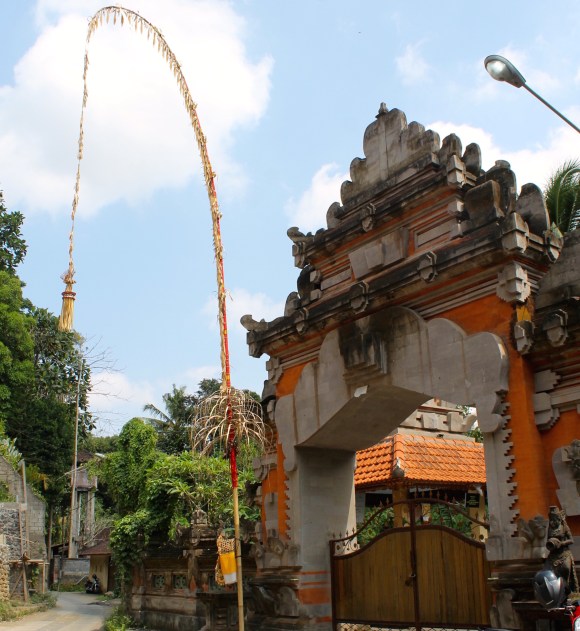
Penjor were pretty much the first thing I noticed about Bali. As soon as we left the airport, they began towering over our car from both sides of the street: long-necked, graceful swoops of bamboo arching and bobbing over the road, their strips of paper and coconut leaves fluttering in the air.
But what were these charming decorations? What was their significance? That took a little longer to find out. And to be honest, I’m still not sure I know.
Let’s start with the basics. Penjor are part of the Balinese Hindu holiday called Galungan. It’s perhaps the most important cultural holiday of the year for Balinese and is said to celebrate the triumph of good (dharma) over evil (adharma). According to various people I asked, the festival also celebrates prosperity and the bounty of the earth. The traditional Balinese calendar has 210 days, so the festival falls at a different time each Gregorian year.
The penjor are constructed in the days leading up to the festival and posted along the street in front of homes and other buildings. There is a vast variety in design, with more intricate designs being a sign of wealth, but there are some elements common to each. The poles, which are usually around eight to 10 meters (26 to 33 feet) long, are made of bamboo and decorated with coconut leaves and a large ornament on the tip that bends it down. They are also supposed to be decorated with root vegetables, grains, fruits, traditional Balinese cakes, and 11 special coins.
During Galungan, the ancestral spirits are supposed to return to homes, so the penjor are also equipped with a small triangular box on the pole called the sanggah cucuk that offers a place for them to reside during their sojourn and a place for the family to place offerings showing gratitude and hospitality. They can also hold offerings to the gods.
Things start getting a little fuzzy when you try to pin down the significance of the penjor and its various elements. Everyone I asked seemed to have a slightly (or totally) different answer.
In one interpretation, the height and strength of the penjor is a visual representation of “uprightness” and the victory of good over evil celebrated during Galungan. In another, the bowed shape is supposed to represent a mountain, specifically Mount Agung, which is the highest mountain in Bali and considered very holy as the incarnation of a mountain god called Hyang Giri Pati. And in yet another, the shape is meant to recall the dragons Ananthaboga and Basuki, respectively representing soil and safety. Depending on who you ask, it seems the penjor could mean any of these things or all of them, or perhaps something else entirely.
Similarly, when asked about the significance of various elements, answers varied. Either they were tied to elements of Hindu mythology and scripture or they were supposed to be much more general images of prosperity and fertility. Or again perhaps both.
Further confusing things is that penjor are now used secularly as well, just as decorations or for other celebrations.
▼ Penjor and similarly shaped flags decorating the stage for a dance performance
▼ Note that they don’t have the box for offerings, though.
On one hand, the inability to pin down an interpretation of something that is clearly a key part of an important holiday was frustrating, but on the other hand, the good-natured lack of concern about the “correct” interpretation was right in line with the cheery, let’s-all-get-along character of the Balinese, so perhaps the vagary is just as it should be.
One thing is for sure, though. Whatever they mean and however they are used, penjor are an absolutely gorgeous part of a distinctly Balinese aesthetic. If you are lucky enough to visit during Galungan, the feeling of strolling under their waving branches and seeing their arched spines backlit against the sky is something that will stick with you forever.
Speaking of which, if you want to see some forests of penjor for yourself, the next Galungan festivities will be held from February 10–20 in 2016.
Photos © RocketNews24 unless otherwise noted